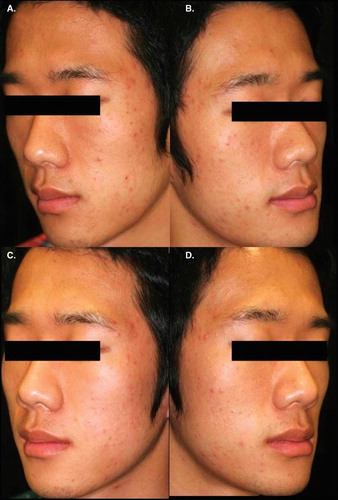Sirs,
Since its ability of producing radical oxygen species was known, chlorophyll's usefulness in photodynamic therapy (PDT) for acne has received great attention (Citation1,Citation2). However, the effect of chlorophyll-PDT for acne has not been reported in the literature so far.
We investigated the efficacy and safety of PDT with chlorophyll in four patients (one female, three males) with mild to moderate acne. Exclusion criteria included: (i) age under 18 years; (ii) cystic acne; (iii) photosensitivity; (iv) recent use of photosensitizing agents; (v) use of oral acne treatments within 4 weeks or topical acne treatments within 2 weeks, use of isotretinoin within 6 months; and (vi) pregnancy or lactation. After vigorous scrubbing with acetone and comedone extraction, a 19% a,b-chlorophyll solution (Delta-blue®; Korea Rub, Korea) was applied randomly onto the right or left side of the face. Thereafter, the ipsilateral face was under occlusion for 30–60 minutes and one pass of intense-pulsed light (Ellipse-Flex®; DDD, Denmark), 6–8 J/cm2 fluence, double-pulse mode, 2.5 ms pulse duration, 10 ms delayed time, was performed on the whole face using a cut-off filter of 530–750 nm (the setting for photo-rejuvenation). After treatment, sun protection was not required. Three sessions of treatment were repeated at 1-week intervals. At each visit and after a 1-month follow-up, clinical findings (including lesion count, global severity score, subjective self-assessment, photography) were assessed. The degree of improvement was measured as 0–25%, 25–50%, 50–75%, and 75–100% (poor, fair, good, and excellent, respectively).
All subjects showed mild improvement after three sessions of PDT. There was a significant reduction in the lesional count at the 1-month follow-up without a significant difference between both sides (). With regard to the global severity score, two patients were downgraded as mild to almost clear and the other two patients remained without a change in grade. Subjective self-assessment revealed that the general acne condition and pore size were ‘fair’ or ‘good’ on both sides of the face. However, all patients felt a definite decrease in sebum production on the chlorophyll-treated side to a degree of ‘good’ to ‘excellent’, whereas they felt the improvement in oiliness was ‘poor’ to ‘fair’ on the light-only side. No patient withdrew from the study due to the adverse effects.
Figure 1. A representative case with excellent outcomes (A,B: before PDT; C: chlorophyll-treated side; D: light only side, after PDT).

Chlorophyll has a similar structure with protoporphyrinogen IX and acts as a photosensitizer when it binds to magnesium (Citation3). The absorption spectrums of chlorophyll range from 400 to 700 nm, and show two peak absorbance levels at 415 nm and 630–664 nm (Citation4). Chlorophyll has some advantages compared to aminolevulinic acid (ALA) or methyl aminolevulinic acid (MAL). First, chlorophyll loses its photosensitizing activity within a few hours. Thus, it does not cause a phototoxic reaction when the treated lesion is exposed to the sun. Second, chlorophyll-PDT only requires a relatively short incubation time in comparison with ALA or MAL because this molecule has the characteristics of a photosensitizer itself. Third, cost-effectiveness can be an important advantage because most acne patients usually go through wax and wane. Chlorophyll costs less than one-tenth of the price of ALA in Korea.
In this study, chlorophyll appears to be able to reduce sebum excretion and may be a convenient alternative to patients who are intolerant to isotretinoin. However, further study of the quantitative measurement of sebum production using sebometry is necessary.
Acknowledgement
This work was supported by the SRC/ERC program of MOST/KOSEF (R11-2005-017-05003-0) and basic research program through the NRF funded by the Ministry of Education, Science and Technology (2010-0002431).
Declaration of interest: The authors report no conflicts of interest.
References
- Douillard S, Olivier D, Patrice T. In vitro and in vivo evaluation of Radachlorin® sensitizer for photodynamic therapy. Photochem Photobiol Sci. 2009;8:405–413.
- Pandey RK, Goswami LN, Chen Y, Gryshuk A, Missert JR, Oseroff A, Nature: A rich source for developing multifunctional agents. Tumor-imaging and photodynamic therapy. Lasers Surg Med. 2006;38:445–467.
- Masuda T. Recent overview of the Mg branch of the tetrapyrrole biosynthesis leading to chlorophylls. Photosynth Res. 2008;96:121–143.
- Nyman ES, Hynninen PH. Research advances in the use of tetrapyrrolic photosensitizers for photodynamic therapy. J Photochem Photobiol B. 2004;73:1–28.
